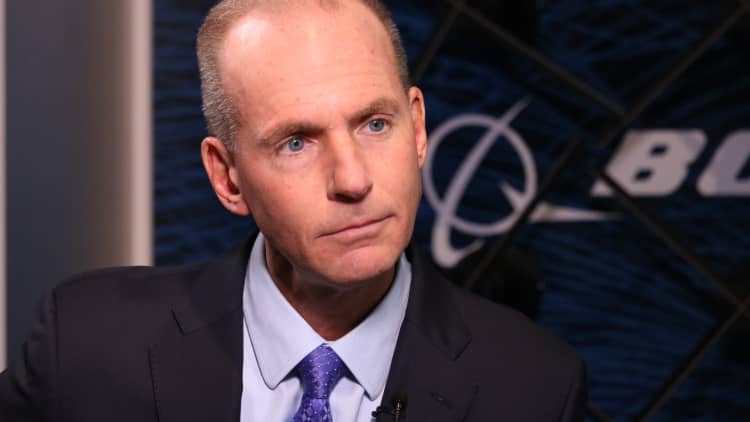More than 300 Boeing 737 jets, including the Max, may have faulty wing parts that don't meet strength and durability standards, the Federal Aviation Administration said Sunday, following a joint investigation with the aircraft manufacturer.
The FAA plans to order airlines to remove and replace the parts if their aircraft are affected, the agency said.
As many as 148 parts made by a Boeing supplier could be "susceptible to premature failure or cracks," the FAA said in a statement about the slat tracks.
Slats are pieces on the front of the wing and move along a track to create lift. They are important during take-off and landing.
Boeing shares fell 0.8% to close at $338.89, recovering from a nearly five-month low hit in morning trading.

The FAA said that while "the complete failure of a leading edge slat track would not result in the loss of the aircraft, a risk remains that a failed part could lead to aircraft damage in flight."
Worldwide, 133 NG and 179 Max planes are affected and of those, 32 Boeing 737 NG and 33 Boeing Max planes are in the U.S.
Boeing said it found that a lower number of planes likely have the suspect parts installed but that it recommended that dozens of others be checked "to ensure a thorough assessment."
The FAA said it will issue an airworthiness directive mandating service actions to remove the parts and that airlines will have to comply within 10 days. The agency said it has alerted international civil aviation authorities of the issue.
Three of Southwest Airlines' 737s NGs and a similar number of its Max planes are affected, according to spokesman Chris Mainz. The carrier is preparing to review the planes' slat tracks "and will fully comply with any service and regulatory requirements," he said in statement. Southwest operates an all-Boeing 737 fleet of about 750 planes.
Peak season
The requirement to remove the parts in question on certain 737s creates a new wrinkle for some airlines that are scrambling to ensure they have enough aircraft during the peak summer travel season. Airlines that fly the 737 Max have had to cancel thousands of flights through August as the planes remain grounded.
Boeing said it is planning to provide replacement parts for its airline customers affected by the slat track issue "to help minimize aircraft downtime while the work is completed," a process it said should take a day or two.
The 737 NG is the model that preceded the 737 Max, which Boeing first delivered to airlines in 2017.
Boeing's CEO, Dennis Muilenburg, last week said the company had to regain the public's trust and apologized to the relatives of victims in the two recent crashes. Executives at some carriers that operate the 737 Max, including United Airlines and Southwest, said they would not charge change fees or fare differences for travelers who are booked on a Max, to switch to a flight on another type of plane.
Boeing's woes
Aviation authorities worldwide, including the FAA, grounded the Boeing 737 Max in the wake of the fatal crash in Ethiopia in March, which killed all 157 people on board. The crash in Ethiopia came less than five months after another Boeing 737 Max plunged into the Java Sea shortly after takeoff from Jakarta, Indonesia, in October killing all 189 people aboard.
The 737 Max's automated anti-stall system is being investigated as a factor in those crashes. Boeing said last month that it has completed a software update for the system to give pilots greater control but the FAA and other regulators need to sign off on its changes before airlines can resume use of the planes.
The crashes have strained relationships between Boeing and some pilots, many of whom said they did not know the system, known as MCAS, existed on the 737 Max until after the Lion Air crash in Indonesia in October. Boeing is also under fire over a cockpit alert that wasn't working aboard 737 Max planes because it told the FAA about it more than a year after it detected the issue.
American Airlines' 737 NGs are not affected by the slat track issues, spokesman Ross Feinstein said.
Dennis Tajer, a Boeing 737 captain and spokesman for the Allied Pilots Association, which represents about 15,000 American Airlines pilots, said because of the surprise of the anti-stall system on the 737 Max, its pilots plan to ask Boeing when and how the newly reported issue of the slat tracks was discovered and when Boeing disclosed it to the FAA.
"We're in a new space now," he said. "These are questions we may not have asked before."
Boeing has about 4,400 orders for the 737 Max planes, the manufacturer's fastest-ever selling jet. After the grounding, it paused deliveries and cut production from 52 a month to 42.
The FAA has not given a timeline for when it plans to certify the 737 Max to fly again.
"The last thing I want is to put a date out there for lifting the grounding," said Dan Elwell, acting administrator for the FAA.




